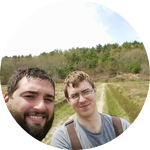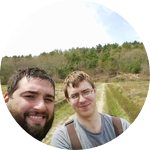About This Project
Restorations of rivers and streams are becoming more and more common to mitigate or repair human impacts, from agriculture, to flood control and energy generation. These restorations are claimed to restore ecosystem services and biodiversity within the streams and rivers, yet remain poorly studied pre- and post-restoration. By comparing restored sites to least impacted systems, we will be able to evaluate whether restoration is truly worth the money.
Ask the Scientists
Join The DiscussionWhat is the context of this research?
Biodiversity is the variation of life, from genetic differences, to species richness, to even ecosystem change across the landscape.
Biodiversity is being lost from rivers and streams at an alarming rate. Much of this loss is due to human related impacts to our freshwater resources. To prevent further loss of biodiversity and gain back some services from the environment, many communities choose to restore these resources. Restorations themselves though are relatively poorly studied.
Tidmarsh Farms in Plymouth, MA is a former cranberry bog situated on a coastal river that is slated for restoration. We want to measure physical, chemical, and biological processes during and after restoration of Tidmarsh and compare to those of a less impacted system.
What is the significance of this project?
Restoration is an understudied field, due to limited money to perform biological sampling after a restoration is completed. In particular, genetic diversity is rarely investigated in projects like this, with the assumption that if the water quality and habitat are restored, genetic diversity will return. Our study will help determine if these assumptions are well founded, or if restoration is only part of the answer to restoring biodiversity.
After restoration, Tidmarsh Farms will become a nature preserve an education center, with ongoing research and outreach for citizen science. The results of this study and several others ongoing in the field will be used to craft educational programs and connect visitors to the landscape in a new way.
What are the goals of the project?
We are hoping to characterize what is happening at Tidmarsh in terms of biological, physical, and chemical processes as well as genetic changes that may be occurring in the stream organisms. We will be comparing these to sites in a less impacted stream and an active cranberry farm to identify what changes are due to restoration specifically.
We'll be identifying the organisms (fish and invertebrates) that live in the stream, evaluating the stream habitat, recording water chemistry, determining limiting nutrients for algal growth, reconstructing the food web through stable isotopes, and determining genetic diversity in fish and insect species. We are looking to identify the biodiversity changes at Tidmarsh at the ecosystem, community, and genetic level.
Budget
Genomic sequencing unfortunately doesn't come cheap. We are using the latest in genomic sequencing technology and although we are preparing all the samples ourselves to cut down on costs, we are still short on funds to perform this analysis on all the species needed to complete the study. Getting matching food web data will allow us to understand the flow of energy in the system and also let us match up our genetic work with each species' position in the food web. Our DNA extractions will be performed using Qiagen kits, and sequenced using Illumina Hi-seq, through our partners at UC Davis. We are lucky to have direct access to Isotope Ratio Mass Spectrometry (IRMS) here at UMass Boston, and thus we only need additional funding to obtain standards from NIST and USGS. We also have some need for basic lab supplies, such as pipette tips and reagents, and field supplies - lab grade ethanol, RNA-later, maintenance of our water chemistry probe, and fish and invertebrate sampling gear.
Meet the Team
Team Bio
Tom and Sean are both PhD students in Environmental Biology at UMass Boston (UMB) in the Freshwater Ecology Lab under the mentorship of Dr. Alan Christian.
They have both been among the first cohort of the university's NSF Integrative Graduate Education and Research Traineeship (IGERT) program. While both interested in freshwater restoration and its impacts, Tom is a population geneticist at heart, asking questions about the impacts of restricted gene flow and isolated populations due to stream barriers. Sean is a more classical ecologist, interested in how restoration is impacting the stream system as a whole - in terms of stream function, structure, and landscape effects.
Before coming to UMB, Sean got his undergraduate degrees in Ecology/Evolution and Environmental Science from the University of Maryland. Growing up close to the Chesapeake Bay made him realize the importance of protecting freshwater and understanding what impacts it. Tom is an AmeriCorp alumnus, who worked on restoration in the Mojave desert. He came back to get his biology degree and eventual PhD at UMB when he discovered his love for genetics research and education.
They are both working within the larger framework of researchers under Tidmarsh Farms' Living Observatory, a collection of researchers from academia, non-profits, and government agencies doing research at this site. Additionally, they have partnered with researchers both at UMB and UC Davis to really address all aspects of biodiversity.
Press and Media
Check out more about the project here!
Project Backers
- 36Backers
- 108%Funded
- $7,050Total Donations
- $157.94Average Donation

